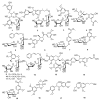Identification of compounds from the water soluble extract of Cinnamomum cassia barks and their inhibitory effects against high-glucose-induced mesangial cells
- PMID: 24013407
- PMCID: PMC6270337
- DOI: 10.3390/molecules180910930
Identification of compounds from the water soluble extract of Cinnamomum cassia barks and their inhibitory effects against high-glucose-induced mesangial cells
Abstract
The difficulty of diabetic nephropathy (DN) treatment makes prevention the best choice. Cinnamomum cassia barks, known as Chinese cinnamon or Chinese cassia, is one of the most popular natural spices and flavoring agents in many parts of the World. Since previous reports indicated that Chinese cinnamon extract could be used for the treatment of diabetes, we proposed that this spice may be beneficial for the prevention of DN. However, the responsible compounds need to be further identified. In this study, we isolated three new phenolic glycosides, cinnacassosides A-C (1-3), together with fifteen known compounds from the water soluble extract of Chinese cinnamon. The structures of the new compounds were identified by comprehensive spectroscopic evidence. Eleven compounds (6-9, 11, 13-18) were isolated from this spice for the first time, despite extensive research on this species in the past, which added new facets for the chemical profiling of this spice. These isolates were purposely evaluated for their inhibitory effects on IL-6 and extracellular matrix production in mesangial cells which are definitely implicated in DN. The results showed that compounds 4-8 could inhibit over secretion of IL-6, collagen IV and fibronectin against high-glucose-induced mesangial cells at 10 mM, suggesting that Chinese cinnamon could be used as a functional food against DN.
Figures






Similar articles
-
Anti-diabetic nephropathy compounds from Cinnamomum cassia.J Ethnopharmacol. 2015 May 13;165:141-7. doi: 10.1016/j.jep.2015.01.049. Epub 2015 Feb 25. J Ethnopharmacol. 2015. PMID: 25725434
-
A new phenolic glycoside from the barks of Cinnamomum cassia.Molecules. 2014 Oct 31;19(11):17727-34. doi: 10.3390/molecules191117727. Molecules. 2014. PMID: 25365297 Free PMC article.
-
Study of Antioxidant, Antiproliferative and DNA Damage Protecting Activities of Cinnamomum cassia Extracts Obtained by Sequential Extraction.Recent Pat Food Nutr Agric. 2021;12(1):45-57. doi: 10.2174/2212798411666200817120307. Recent Pat Food Nutr Agric. 2021. PMID: 32807070
-
Cinnamomum cassia Presl: A Review of Its Traditional Uses, Phytochemistry, Pharmacology and Toxicology.Molecules. 2019 Sep 25;24(19):3473. doi: 10.3390/molecules24193473. Molecules. 2019. PMID: 31557828 Free PMC article. Review.
-
Aqueous Extract of Cinnamon (Cinnamomum spp.): Role in Cancer and Inflammation.Evid Based Complement Alternat Med. 2023 May 11;2023:5467342. doi: 10.1155/2023/5467342. eCollection 2023. Evid Based Complement Alternat Med. 2023. PMID: 37215636 Free PMC article. Review.
Cited by
-
Metabolism of Diterpenoids Derived from the Bark of Cinnamomum cassia in Human Liver Microsomes.Pharmaceutics. 2021 Aug 23;13(8):1316. doi: 10.3390/pharmaceutics13081316. Pharmaceutics. 2021. PMID: 34452277 Free PMC article.
-
The Effect of Plant Additives on the Stability of Polyphenols in Cloudy and Clarified Juices from Black Chokeberry (Aronia melanocarpa).Antioxidants (Basel). 2020 Aug 27;9(9):801. doi: 10.3390/antiox9090801. Antioxidants (Basel). 2020. PMID: 32867376 Free PMC article.
-
Metabolomic profiling and comparison of major cinnamon species using UHPLC-HRMS.Anal Bioanal Chem. 2020 Nov;412(27):7669-7681. doi: 10.1007/s00216-020-02904-1. Epub 2020 Sep 2. Anal Bioanal Chem. 2020. PMID: 32875369 Free PMC article.
-
Assessment of the effeCt of lIfestyle iNtervention plus water-soluble ciNnAMon extract On loweriNg blood glucose in pre-diabetics, a randomized, double-blind, multicenter, placebo controlled trial: study protocol for a randomized controlled trial.Trials. 2016 Jan 5;17:9. doi: 10.1186/s13063-015-1138-7. Trials. 2016. PMID: 26732017 Free PMC article. Clinical Trial.
-
Transcriptome Analysis of Cinnamomum chago: A Revelation of Candidate Genes for Abiotic Stress Response and Terpenoid and Fatty Acid Biosyntheses.Front Genet. 2018 Nov 5;9:505. doi: 10.3389/fgene.2018.00505. eCollection 2018. Front Genet. 2018. PMID: 30455715 Free PMC article.
References
-
- Ha H., Hwang I.A., Park J.H., Lee H.B. Role of reactive oxygen species in the pathogenesis of diabetic nephropathy. Diabetes Res. Clin. Pract. 2008;82s:s42–s45. - PubMed
-
- San K. Role of spices beyond food flavoring: Nutraceuticals with multiple health effects. Food Rev. Int. 2005;21:167–188. doi: 10.1081/FRI-200051872. - DOI
Publication types
MeSH terms
Substances
LinkOut - more resources
Full Text Sources
Other Literature Sources
Miscellaneous

